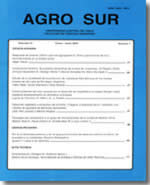EFECTO DE LA SOLARIZACION SOBRE MALEZAS DE TOMATE (Lycopersicon esculentum Mill.) EN EL ALTO VALLE RÍO NEGRO Y NEUQUÉN
Main Article Content
Abstract
Effect of solarization on tomato weeds in the Alto Valle of Río Negro and Neuquén.
During 1999 and 2000, the effectiveness of solarization as weed control method was studied on a horticultural field at Cinco Saltos, Río Negro, Argentina (38º 56’S y 67° 59’ O; 250 msm). A completely randomised block design, repeated three times, was established for two treatments: solarized, and non-solarized. Plots were covered for 8 weeks with a 100µ thick transparent polyethylene film during January and February, and temperatures were recorded daily at two depths: 10 and 30 cm. Weed seed bank and weed covering were analysed. A solarization period of 8 weeks, during January and February, provided a 59% decrease in shallow layer’s seed bank (0 to 10 cm), plus another 2% in the deeper layer (10 to 25 cm). Although some weed species, like Capsella bursa-pastoris, Cichorium intybus, Portulaca oleracea and Sisymbrium irio was apparently achieved in treated plots, solarization by itself did not avoid weed growth throughout the season, so further weed removal was necessary.

